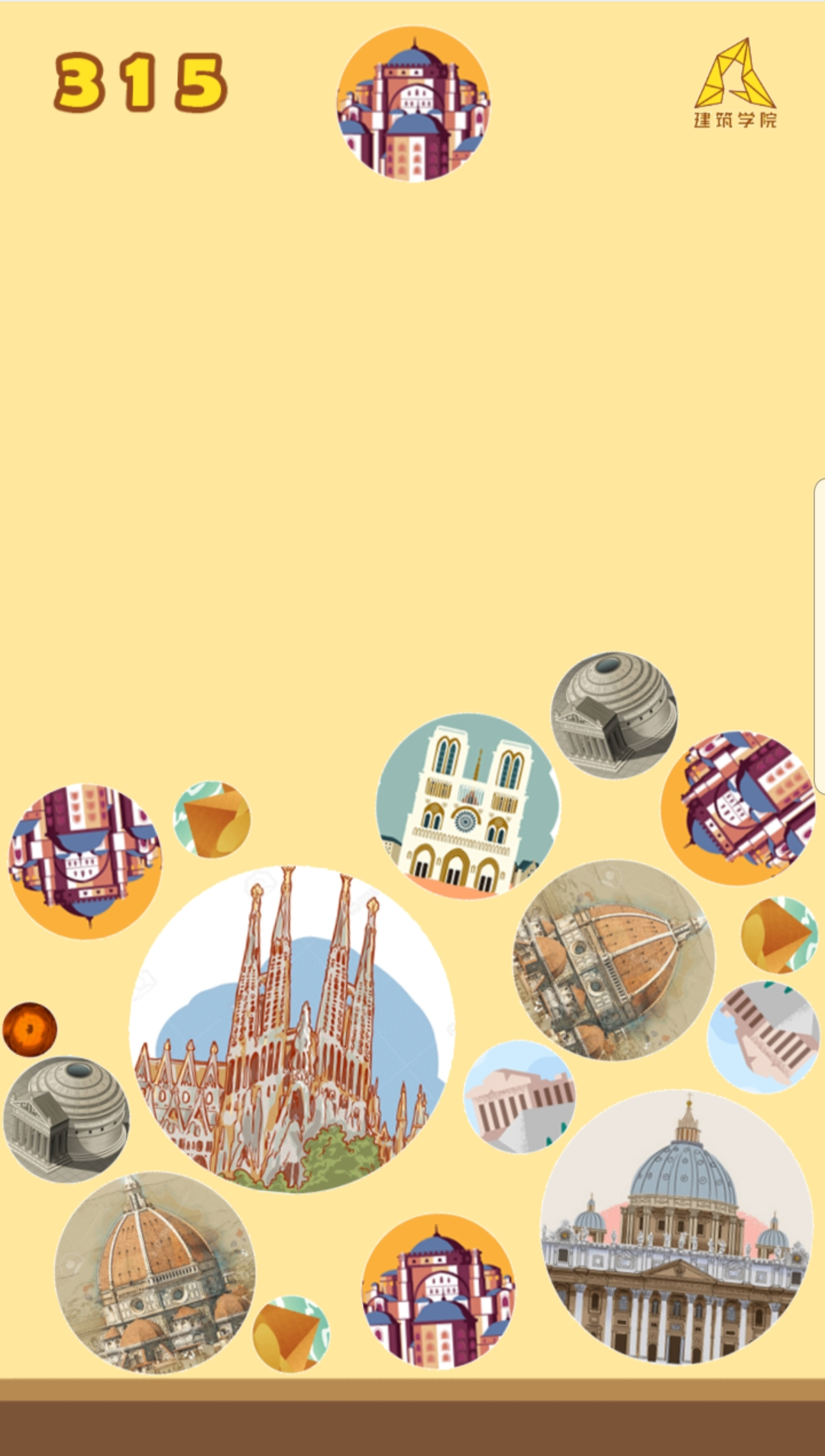This is the second chapter of the Spring Festival Series “synthetic architecture” of the school of architecture, which is modified from the recent popular game “synthetic watermelon”
. 
Through this game, I hope to help you briefly review our impression of architecture and have a more fun and meaningful Spring Festival
. 
Long press the identification QR code to enter the game “synthesis of Western architecture” synthesis of Western architecture, select 11 buildings: cave, pyramid, Parthenon, Pantheon, St
.
Sophia Cathedral, Notre Dame, Notre Dame, St
.
Peter’s church, Savoy villa, multi architecture
.
They are the most important buildings from different periods in the West
.
They are not only the cultural symbols of their times, but also contain some technical and ideological changes
.
Of course, they also have obvious inheritance relationship with each other
.
Caves, pyramids, ancient Greek temples, from the primitive times to ancient Greece, natural belief and polytheism determine the form of architecture, but the structural system still remains in the original state, and the architectural activities are still relatively slow
.
Cave: primitive architecture
.
All over the world, no matter which country, there are obvious similarities in the origin of architecture and some ways of belief
.
For example, the origin of architecture is generally cave dwelling and nest dwelling
.
Besides being a shelter, how do caves shape human beliefs? Pyramid: after people had the early shelter, they gradually formed the settlement and community
.
The bad environment and the connection between the settlement eventually promoted the common belief of human beings
.
In fact, both the early belief in nature and the religious belief are discussing a pair of important propositions: life and death
.
“How to treat death” has become an important prerequisite for the future social development
.
This hidden power drives the evolution of architecture in the next few thousand years
.
Therefore, the pyramid is particularly important here
.
It shows the Egyptians’ attitude towards death
.
From a flat and ordinary tomb, mastaba gradually became a pyramid
.
Such a simple tetrahedron has become our first impression when we imagine immortality today
.
Parthenon: in fact, when talking about pyramids, maybe we should add Egyptian temples, because from the perspective of inheritance, Egyptian temples are more meaningful to Greece
.
The pyramids declined after the rise of the priesthood
.
In the heyday of ancient Egypt, the pyramids were hidden in the deepest part of the temple
.
The most impressive feature of Egyptian temples is the dense forest of stone pillars
.
Today, we know that there are several unique Greek pillars, such as Doric pillar, Ionian pillar and Corinthian pillar, which symbolize men, women and nature
.
Obviously, they all come from the pillars that the Greeks learned from Egypt, but their polytheism, pursuit of freedom and exploration of philosophy make them endow more human symbols in the form of pillars and buildings Number and scale
.
The Acropolis of Athens and Parthenon are the witnesses of all this
.
Roman temple, St
.
Sophia Cathedral, Gothic church, structural system reform and material development constitute the basis of the Roman Empire and medieval construction activities
.
Whether it is a huge dome or a towering temple, they strive to create monumental buildings, but also seek greater internal space to meet the daily and religious life of the citizens
.
Pantheon: compared with the ancient Greeks, the ancient Romans had more diversified urban public life
.
All these rely on the construction technology of ancient Rome
.
The inclusive Romans absorbed Greek culture and learned from their temples, but most importantly, they succeeded in turning the archery technology into a structure suitable for all buildings
.
Although the technology was invented by the Sumerians, the Greeks and even the remote Chinese, only Rome succeeded in building cities with it
.
The reason is that the Roman people have a lot of volcanic ash, which is the most important material to make concrete in ancient times, so the history of Roman architecture can be said to be the history of concrete
.
Pantheon is the epitome of this technology
.
Its designer is Hadrian, one of the most romantic and ideal architects in Rome
.
This seemingly ordinary building, like a barn, has been the record of the largest dome in Europe for a long time
.
The light from its internal ceiling once illuminated the world of some great architects in the Renaissance and modernism, such as bernalewski and Corbusier
.
St
.
Sophia’s Cathedral: when the Western Roman Empire was reduced to barbarism, Roman architectural technology gradually declined
.
Fortunately, Byzantium renewed the face of the Empire
.
In order to show the status of the emperor, they abandoned the basilica layout centered on the Pope and changed it into a centralized church, and then invented a new vault technology of “sail arch + drum seat + dome”
.
St
.
Sophia’s Cathedral is the epitome of this technology, which uses a combination of Basilica and centralism
.
Light enters the room through 40 brick arched windows
.
The walls are covered with Christian murals and decorations
.
Unfortunately, these exquisite murals were later erased in the anti idol movement in the 8th century, and in the 15th century, Turkey transformed them into mosques
.
Notre Dame de Paris: in Western Europe, Roman construction technology was lost
.
It was not until the 8th century that Italy gradually recovered a little memory
.
This is also the source of “Romance” before Gothic church
.
The short revival brought by “Romance” spread from Italy to France and other countries
.
Craftsmen gradually developed cross rib arch technology into pointed arch, which made the church have enough internal space to open large windows
.
In addition, in order to cater to the heaven worship that Christianity wanted to shape, the church was built higher and higher, and the steeple rose into the sky
.
From the Renaissance to the end of the 19th century, the development of capitalism has brought ideological emancipation, and the pursuit of humanistic spirit has driven architecture to be more standardized and humane
.
The birth of drawings, the taboo of architects and the construction of theories all constitute our cognition of “architecture” and “architect” today
.
Notre Dame Cathedral: after the dark, dirty and poor middle ages, the development of capitalist economy and geographical discovery ignited the birth of the Renaissance
.
An important symbol of the Renaissance was the construction of the dome of Notre Dame Cathedral in Florence
.
The first architect with a name, brunalesky, rediscovered some important spiritual symbols and construction techniques from Roman and Greek architecture, and applied them to this church
.
St
.
Peter’s Cathedral: it focuses on the greatest Italian architects around the 16th century
.
Its layout experienced repeated struggles from concentration to Latin cross and then to concentration, which implied the conflict between the architect’s personal ideal and the church’s will
.
Then Michelangelo completed the dome design, and the church was covered with Bernini’s sculptures
.
But after his death, the church commissioned Maderno to add a section of basilaca style hall
.
In the end, the struggle mentioned above ended with the victory of the church
.
What’s more, maldino added a 51 meter large porch full of Baroque style carvings and double columns
.
In front of it, San Marco Square designed by Bernini is the most classic Baroque colonnade
.
Baroque, in a period of time swept Europe, and then abandoned
.
St
.
Family Church: after Baroque, Rococo and French classicism, people began to rethink architecture
.
Just like in the Renaissance, they tried to find vitality in ancient Greek and Roman architecture, which became the main theme of architectural activities in the 19th century
.
With this anti decoration trend, there were also the development and application of building materials for Crystal Palace and Eiffel Tower The development of art movement.
.



